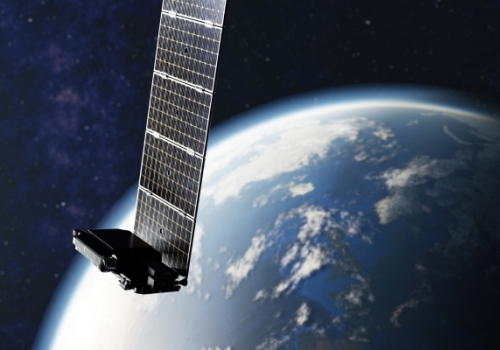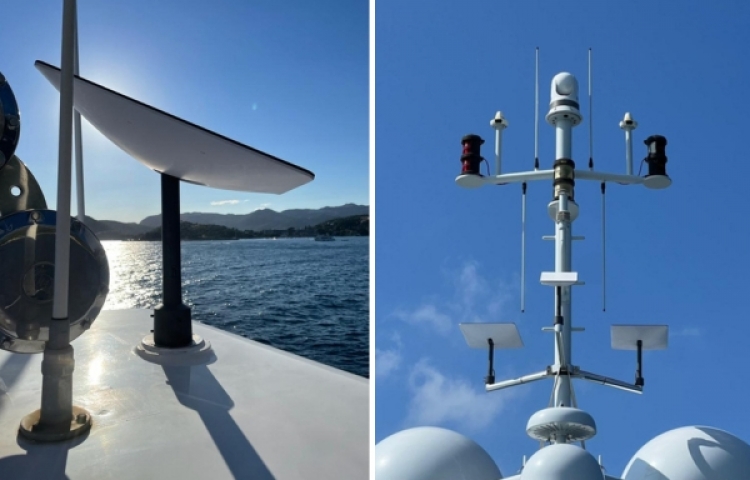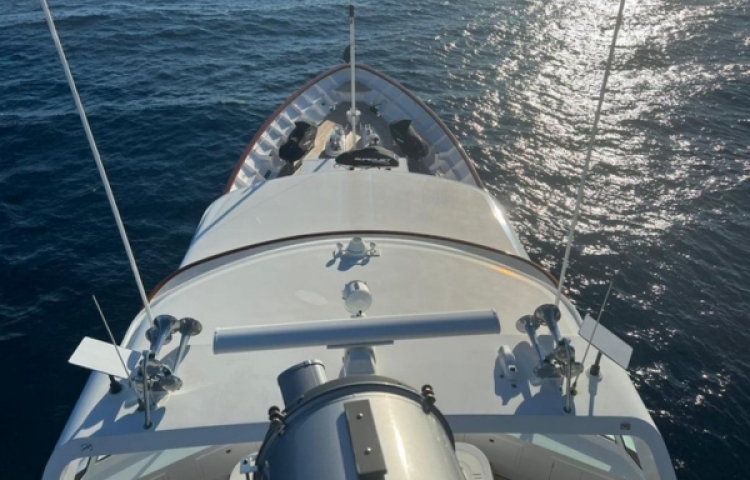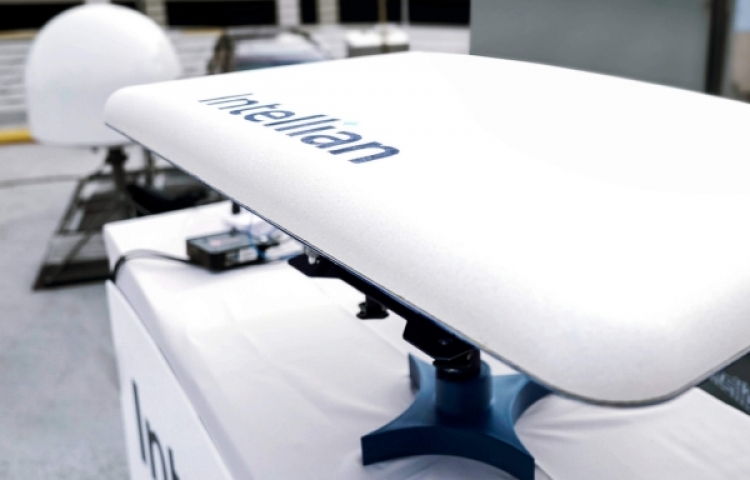The Tech Giants Fighting for Your Yacht’s Internet Connection

They look like a mysterious but mesmerising string of glistening pearls streaking across the night sky, and they’re unlike anything else (naturally occurring, anyway) that’s already up there.
The unusual sight is enough to send people flocking to social media to report the arrival of aliens, but in fact what we’re witnessing is a historic arrival of a different kind: Starlink.
Owned by the infamous Elon Musk, Starlink is a network of Low Earth Orbit (LEO) satellite arrays, and apart from inadvertently sowing panic about the arrival of aliens amongst the uninformed, more importantly, it’s changing the way people all over the world access and use the internet.
And while Starlink is currently the most established and credible LEO satellite internet provider, it’s already clear to us that it will certainly not be the last to enter this exciting new market. Big names including Jeff Bezos’ Amazon have thrown their hat into the ring and soon, yachts - and everyone else - will be truly spoilt for choice in the satellite internet game.
In our last article with TSM Superyacht Technology, we discussed how LEO satellite internet is changing the internet game for the maritime industry, especially the superyacht sector.
Now, once again in partnership with TSM Superyacht Technology, we’re going for a spacewalk to take a more detailed look at the who’s who of LEO satellite internet, both existing and still to come.
Starlink: A Musk-have for superyachts
For the first time since the internet’s invention, Starlink has delivered the technology and infrastructure to access the internet at high speeds from *almost* anywhere on Earth.
Officially, Starlink is ‘the world’s first and largest satellite constellation using a low Earth orbit to deliver broadband internet capable of supporting streaming, online gaming, video calls’ and everything else you’d want to do online.
The company has leveraged its ownership of SpaceX to quickly deploy a large network (or ‘constellation’ as they put it) of thousands of satellite arrays. Orbiting the Earth at an altitude of just 550kms, Starlink claims to deliver a uniquely low-latency internet connection of about 25ms - much lower than traditional geostationary satellite internet networks that routinely average 600+ms.
Starlink says that its network, which will eventually include 12,000 satellites, is already delivering internet to ‘the vast majority of the Earth’s oceans and seas’. And of course, superyachts are lining up to take advantage of this new technology.
Flattening the curve
Customers access the Starlink service using a standalone satellite receiver panel which the company also calls a Starlink. For maritime applications, the Starlink antenna is a flat panel that installs onto any flat surface above deck that gives it an unobstructed view of the sky.
Starlink’s uniquely flat, low visual profile makes it virtually invisible to the casual observer. This potentially heralds an interesting new dimension in yacht design in that yachts may no longer have any need for the sometimes large radomes on their masts.
Having said that, there is still a place for VSAT systems thanks to their reliable, global coverage, even if it’s kept as a fallback system for Starlink or similar. TSM works with some of the top VSAT partners in the industry and is able to provide flexible, non-contractual solutions to suit every vessel’s needs.
But while superyacht owners line up to get Starlink installed on their yachts, Amazon and others are quietly preparing their own systems for launch. Let’s take a look.
Project Kuiper: A Prime contender
Project Kuiper is Amazon’s answer to Starlink. Promising to deliver internet services via satellite to provide internet connectivity to underserved or unserved communities, Project Kuiper plans to ultimately put 3,236 satellites into orbit. And in terms of Amazon’s FCC operating license, it is required to have deployed at least half of that total by 2026, so the clock is ticking.
The new service, according to Amazon, will be ‘capable of providing reliable, affordable broadband service’ to some of the 30% of the earth’s population who have never even used the internet.
To get its satellites into orbit, Amazon says that it has booked 77 heavy-lift launches from a group of launch partners, including Arianespace, Blue Origin and United Launch Alliance. For obvious reasons, SpaceX is not on the list.
Terminals for the masses
Similarly to Starlink, Project Kuiper’s satellite terminal will be flat, compact and robust, and it seems like there will be terminals for three applications, including portable use, residential use, and commercial applications. Those commercial applications will cover the maritime and similar sectors. The commercial unit is physically the biggest of the three but will also offer the fastest speeds - apparently as much as gigabit speeds - so that model is likely to be on the expensive side.
Amazon is far behind Starlink in terms of Starlink’s satellite infrastructure, given that Amazon’s first two prototype satellite launches are only planned for sometime in 2023. Following that, Amazon wants to begin mass production of its satellites.
If everything goes according to plan, Amazon hopes to begin serving its first customers with satellite internet connectivity by the end of 2024.
OneWeb - One service to rule them all
OneWeb is a British communications company rolling out a similar network of broadband satellite internet services.
Founded in 2012, OneWeb began launching satellites in February 2019, only to enter bankruptcy a year later in March 2020.
Unusually, the company later successfully emerged from the bankruptcy proceedings and now has new owners in the form of an international group of investors spanning the UK, India, France and Japan.
After suffering numerous setbacks relating to the war in Ukraine and sanctions against its Russian launch partners, OneWeb signed a launch agreement with SpaceX to launch its remaining Falcon 9 rockets.
As of the time of writing this article, OneWeb claimed to have 648 satellites in orbit.
On the hardware front, OneWeb offers two options: One is a pair of dual parabolic antennas by Intellian which are able to make use of the full bandwidth available on the OneWeb network. The other option is a flat panel by Kymeta - visually somewhat similar to Starlink but much larger and which is ready to fit onto a typical TVRO/VSAT radome bolt pattern.
Intellian, meanwhile, plans to launch its own flat-panel antenna in 2024.
Get the best onboard connectivity and entertainment
TSM Superyacht Technology delivers the ultimate in connectivity solutions at sea, as well as mind-blowing onboard entertainment with state-of-the-art audio and video systems for crisp sound quality and stunning visuals.
TSM already has relationships with Starlink and OneWeb and expects to be able to provide Amazon’s Project Kuiper products as well, in due course. Indeed, with so many superyachts already benefiting from TSM’s connectivity packages, why not give them a call for a tailor-made solution.
Contact TSM today to learn how owner Scott Galloway and his skilled team can take your connectivity, entertainment and leisure time at sea to the next level.






Post your comment
You cannot post comments until you have logged in.
Login to post a commentComments
No one has commented on this page yet.
RSS feed for comments on this page | RSS feed for all comments